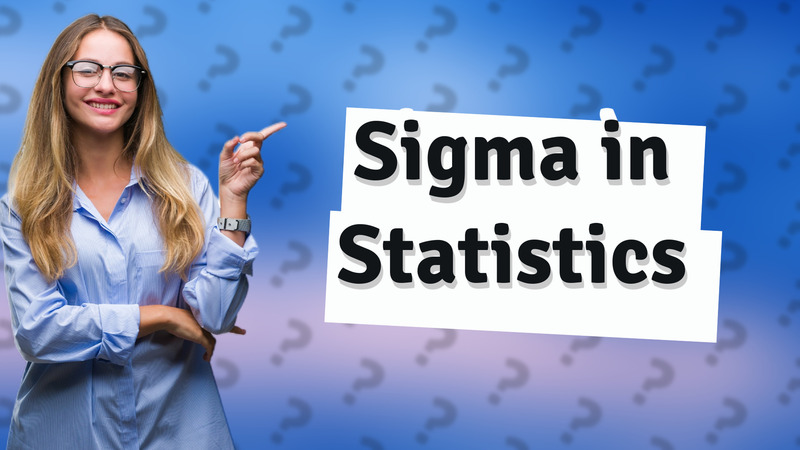
Learn the method to reverse engineer Excel formulas for clearer understanding and troubleshooting.

Learn how to calculate the average in Excel using the AVERAGE function for effective data analysis.

Learn how the 68-95-99 rule applies to data distribution in statistical analysis and quality control.

Learn what reverse typing is and how it helps in debugging and cybersecurity through data analysis.

Learn why calculating averages is vital for data analysis and decision-making across various fields.

Learn how to calculate the 3-month average method for accurate trend analysis and financial insights.

Learn how sigma impacts quality control and decision-making in real life.

Explore whether a low sigma value indicates quality in datasets that measure variation and dispersion.

Discover what 'prime' means in statistics and how it aids in variable distinction.

Learn how Sigma 2 rules improve detection of process anomalies in quality control.

Learn what R-squared (R2) means in regression analysis and how it measures model fit and explanatory power.

Learn to easily calculate the mean using the averaging formula for different applications.

Learn how to calculate the mean using the simple average method to analyze data effectively.

Learn what the triangle time symbol means in statistics and its importance in data analysis.

Learn what reverse coding is and how it impacts data analysis. Discover its importance in surveys and data interpretation.

Learn about the binary approach in decision making—its applications, benefits, and relevance in data analysis and computer science.

Explore the learning curve for SAS and how to ease the process with available resources.

Learn how to use the AVERAGEIF function in Excel to calculate averages based on specific conditions.

Learn about the monthly average, its importance, and how to calculate it for data analysis.

Learn about the four key types of analytical communication: quantitative, qualitative, textual, and visual analysis.

Explore the four essential components of modeling: data collection, preprocessing, model building, and evaluation.

Learn what ΣX represents in statistics and how it is used for data analysis, including mean and variance calculations.

Explore the rarity of sigma levels and what it means for data precision and quality control.

Learn what the Two Sigma Rules are and how they enhance quality control and risk management in organizations.

Learn how to calculate the sum of squared frequencies with this simple, step-by-step process.

Discover the rarity of 4 sigma in statistics, where events occur roughly once in 25,000. Explore its significance in data analysis.

Discover the meaning of 5 sigma and its importance in statistics and quality control metrics.

Explore why summation is crucial for simplifying complex problems in mathematics, statistics, and data analysis.

Discover why 2 sigma is superior to 1 sigma for effective quality control in statistics.

Learn what the Σ symbol means in Excel and how to use the auto-sum function for quick calculations.

Discover how 2 sigma influences accuracy in data distribution analysis and its implications for statistical reliability.

Discover the significance and rarity of 3-sigma events in statistical analysis and data monitoring.

Learn how to calculate the correlation coefficient (r) by hand using a step-by-step method. Perfect for beginners!

Learn the formula to calculate average class attendance and understand overall attendance trends effectively.

Discover what sigma (σ) represents in statistics and its impact on data variability and quality control.

Explore what σ (sigma) means in statistics and its role in measuring data dispersion and variance.

Discover the fundamentals of binary hypothesis testing, including null and alternative hypotheses, and their significance in research.

Learn what σ signifies in statistics and how it reflects data variation. Explore the importance of standard deviation.

Learn how to clear bad data effectively with proven methods to enhance accuracy and decision-making.

Learn about the simple average method for calculating central tendency in your dataset. Discover how it works and its significance.

Learn to write the COUNTIFS formula in Excel to count cells with multiple criteria easily.

Learn the basic rule of average, how to calculate the mean, and its importance in data analysis.

Learn the formula for the average method and how to apply it easily in data analysis.

Learn effective methods to evaluate attendance, analyze patterns, and address issues in your organization.

Discover how to select the best method of average for your data to gain accurate insights.

Explore the theory of prediction, its components, and applications in various fields.

Learn the simple formula for calculating average in Excel using =AVERAGE(range) in this quick tutorial.

Discover the significance of horizontal lines in data visualization and architecture. Learn how context influences their interpretation.

Learn how to set up smart alerts using advanced settings for better notifications.

Discover the ideal length for inquiry cycles to enhance research and project outcomes.

Explore how gamma measures the relationship between ordinal variables in statistics.

Explore the significance of high log gamma values in machine learning and their role in predictive modeling.

Discover the hardest part of SAS training and how to master it with tips for improving your skills.

Explore the differences between SAS and SBS in geometry and data analysis. Learn which method suits your needs best!

Discover why crossing is critical in traffic safety, sports plays, and data analysis to enhance safety and performance.

Learn about digital twins, their applications, and how they optimize processes in various industries.

Discover the 8 key steps of scientific inquiry, from formulating questions to reporting results, for effective research techniques.

Explore the differences between Sigma and Omega to determine which better fits your analytical or engineering requirements.

Explore the principles of classification and learn how we categorize animals, books, and more for easier understanding.

Learn what sigma means in statistics and how it measures data variation. Discover its importance in analyzing datasets.

Learn about true sigma in statistics, its impact on data variation, and its importance in financial prediction.

Learn about scoring formulas and how they quantify performance in academics, sports, and finance.

Learn the meaning of Sigma (σ) in statistics. Discover its significance in measuring data variability and calculations.

Discover the essential characteristics of effective science models for better predictions and understanding.

Discover what ∑xi means and how to calculate the sum of values in a dataset. Learn the basics of this important statistical concept.

Learn about the SUM function, the sigma equivalent in Excel and Google Sheets, for quick cell addition.

Learn about the 2x2 model, a powerful tool for decision-making and analysis, including its application in SWOT analysis.

Discover how sigma defines standard deviation in statistics and enhances process quality in Six Sigma methodology.

Learn what sigma means in statistics and how it relates to standard deviation and data variability.

Discover what a 13-digit number is called and its applications in finance and data analysis.

Learn the distinctions between hit ratio and win ratio, crucial for performance tracking in tech and sports.

Explore if sigma, the standard deviation in statistics, can ever be zero and what it means for your data analysis.

Learn about sigma (σ) and its role in representing standard deviation in statistics. Discover its significance in data analysis.

Learn what sigma (σ) and mu (μ) mean in statistics, including their roles as standard deviation and mean.

Explore how sigma notation simplifies complex calculations in finance and education, making data analysis more efficient.

Learn what Σ means in standard deviation and how it plays a crucial role in data analysis.

Explore how sigmas simplify data distribution and error measurement in mathematics.

Discover the role of \u03c3 in statistics, measuring standard deviation and its importance in data analysis.

Learn how the 3 sigma rule helps in identifying outliers and ensuring quality control in datasets. Discover its importance in statistics.

Discover what a negative sigma means in statistics and its applications in quality control and risk management.

Explore the importance of sigma in statistics and its role in quality control and process improvement.

Learn the key differences between alpha and sigma in statistics and their significance levels in data analysis.

Explore the meaning of 5 sigma in statistics and its importance in particle physics with our concise Q&A.

Learn what σ in statistics means and its importance in measuring data variation. Discover how it impacts fields like finance and engineering.

Discover why a 4-point rating scale enhances feedback collection and analysis, driving impactful insights.

Explore how rare sigmas are in statistics and mathematics, focusing on their significance and contexts of use.

Explore how scientists utilize models to study climate change, disease spread, and more.

Learn about Sigma 2 and its significance in statistics, measuring data spread, and its applications in quality control.

Discover whether Six Sigma requires advanced math skills or if anyone can learn it! Explore user-friendly techniques for process improvement.

Learn what 2σ means in statistics and how it relates to confidence intervals and data distribution.

Learn how to determine the t-star value for confidence intervals and hypothesis tests effectively.

Explore the concept of 1 sigma, a key measure of statistical variation from the mean.

Learn how background information enhances understanding of climate change and its impacts. Discover effective examples and insights.

Learn why sigma is essential for measuring data reliability and making informed decisions.

Learn how to compute ΣfX to find weighted averages in statistics with this concise guide.

Learn about the significance of 2 sigma in statistics and its impact on data analysis and quality control.

Learn what sigma means in statistics and how it measures data variation for consistency and reliability.

Learn what sigma means in statistics and its importance in measuring data variability.

Learn what the sigma button is and how it simplifies summation in spreadsheets like Excel.

Learn how to find the T critical value using a T-distribution table and online calculators. Perfect for statistics students!